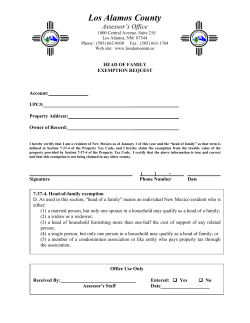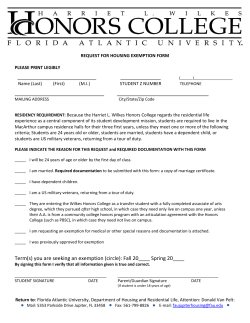
Specific questions to RoHS Exemption Request 2015-3
www.oeko.de Exemption Review under Directive 2011/65/EU Consultation Questionnaire Exemption Request 2015-3 Exemption Request for „Lead as an activator in the fluorescent powder ( 1% lead by weight or less) of discharge lamps when used for phototherapy lamps containing phosphors such as BSP (BaSi2O5: Pb)“ Abbreviations and Definitions Pb Lead BSP Barium Silicate Phosphor (BaSi2O5: Pb) Background The Oeko-Institut together with Fraunhofer IZM has been appointed by the European Commission within a framework contract1 for the evaluation of exemptions to be included in or deleted from Annexes III and IV of the new RoHS Directive 2011/65/EU (RoHS 2). Lighting Europe has submitted an exemption request with the above mentioned wording. Lighting Europe request an exemption to allow using lead as an activator in the fluorescent powder of discharge lamps, containing phosphors such as BaSi2O5: Pb (BSP), when used for phototherapy treatment. Lead activated phosphors for tanning lamp applications are covered by Exemption 18b of Annex III of RoHS, however it is explained that phototherapy applications would not fall under the scope of this exemption. Similarly, Ex. 34 of Annex IV of the Directive allows the use of such lamps in extracorporeal photopheresis, but is understood to exclude other medical applications. The application has been subject to a first completeness and plausibility check. The applicant has been requested to answer additional questions and to provide an exemption wording formulation that limits the scope of the exemption to the use of the specified applications in such devices. Answers can be viewed on the request webpage of the stakeholder consultation: (http://rohs.exemptions.oeko.info/index.php?id=223). According to the applicant, UV discharge lamps are used for many skin treatment applications such as PUVA phototherapy2. Such treatments are performed under medical supervision, whereas the lamps are installed in dedicated phototherapy equipment. Lighting Europe explain PUVA phototherapy lamps to be light sources that produce ultraviolet light in the regions of the UVA and UVB spectrums. Their intent is to produce artificial sunlight to replicate sunlight exposure for the human body (similar to that as produced by the sun) yet applied in calculated doses as regulated by European regulations. These lamps use fluorescent materials (also named phosphors) in order to produce a specific light spectrum, important for the efficiency of treatment. The 2 Lighting Europe explain that PUVA phototherapy is a very specific application enabling effective skin treatments used in medical applications; For instance, a photochemical treatment where a combination of a drug e.g. Psoralen in combination with UVA radiation is used to treat skin diseases as psoriasis, vitiligo, atopic dermatitis etc. 1 Exemption Review under Directive 2011/65/EU primary wavelengths of “light” produced by these lamps are in the UVA and UVB regions or 290400nm. BaSi2O5:Pb phosphors are used, containing 1% or less lead, which is an activator for these fluorescent powders. The lead activator is required to allow the barium silicate phosphor to fluoresce. It transforms the 254 nm radiation to the requested UV (290nm-400nm) radiation. Lighting Europe explains that the presence of lead is important for producing the specific spectrum of the light output to ensure the effectiveness of the various treatments. A reduction in the lead content would cause either a loss of output or not be sufficient to activate the phosphor. Using other phosphors that do not contain lead would result in a change in the output spectrum, impacting the efficiency of the treatments. Lighting Europe claims that there are no alternative non-lead activated phosphors available today that provide the same or equivalent spectral radiation. For details, please check the applicant’s exemption request at: http://rohs.exemptions.oeko.info/index.php?id=223 Questions 1. Do you agree with the proposed exemption wording and its requested duration? If not, please provide an alternative wording. 2. Do you share the applicant’s arguments, or are you opposed to the requested exemption? Please explain your answer in detail, in particular if you oppose the requested exemption. Additional arguments in support of the request may also be detailed. 3. The applicant has explained that these lamps are used for PUVA phototherapy treatments. It is also know that lamps using similar phosphors are used in extracorporeal photopheresis3. a. Are such lamps in use for additional types of medical treatments? b. Please detail medical conditions for which UV discharge lamps with lead activated BSP phosphors provide the only type of effective treatment for patients. 4. Do you agree to the applicant’s statements that there are no alternative lead-free lamps which could produce an equivalent spectral output? Please provide information on lead-free UV lamps used in phototherapy treatment which could be used as an alternative to these lamps. 5. The exemption has been requested for both Categories 8 (medical devices) and 9 (monitoring and control instruments). However, information was not provided by the applicant concerning Category 9 applications, using the same kind of BSP phosphors. a. Please provide information as to Category 9 applications using UV lamps with BSP phosphor. b. Are you aware of other applications of UV discharge lamps (using BSP phosphor) in other equipment, which is in the scope of the RoHS Directive? 3 2 See the report Gensch et al. (2013), Assistance to the Commission on technological, socio-economic and cost-benefit assessments related to the implementation and further development of EU waste legislation: Study to assess RoHS, exemptions – Pack 1, Gensch, C.-O.; Baron, Y.; Blepp, M.; Manhart, A.; Moch, K.; Deubzer, O.; together with Hogg, D.; Eunomia Research & Consulting Ltd. in cooperation with Oeko-Institut e.V. & Fraunhofer IZM; Prepared for the EU Commission, DG Environment, Brussels 6. Please provide information concerning any other aspects you deem to be of importance for the requested exemption. In case parts of your contribution are confidential, please clearly mark relevant text excerpts or provide your contribution in two versions (public /confidential). Finally, please do not forget to provide your contact details (Name, Organisation, e-mail and phone number) so that Oeko-Institut/Fraunhofer IZM can contact you in case there are questions concerning your contribution. Please also note, however, that requested exemptions cannot be granted based on confidential information! 3
© Copyright 2025









